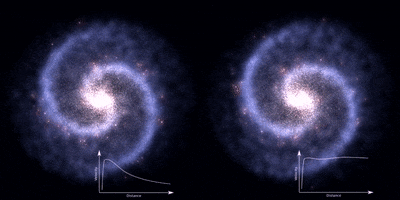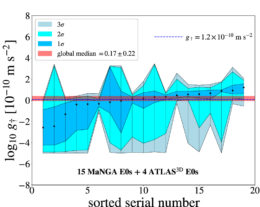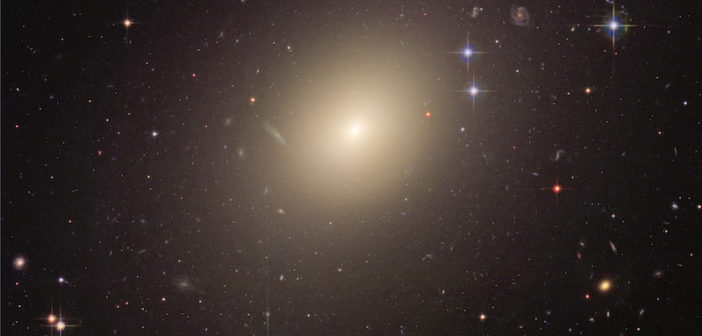In the outer reaches of galaxies, stars don’t move quite how they should. Is this deviation due to mysterious dark matter? Or is something else at work? In a recent study, scientists turn to elliptical galaxies in search of new clues.
Weirdness in Galactic Fringes

Two rotating galaxies are shown with their rotation curves in this animated gif. Based on the distribution of visible matter, we would expect to see inner stars moving fast and outer stars moving slowly, producing a rotation curve like what’s seen on the left. Instead, we see stars moving with the same speed, producing the flat rotation curve seen on the right. [Ingo Berg]
You might think that galaxies would work the same way. Since most of a galaxy’s visible mass is concentrated at its center — just like most of our solar system’s mass (the Sun) is at its center — we would expect stars near the center of a galaxy to orbit quickly, and stars in the galaxy’s outermost fringes to orbit very slowly. Instead, we see that stars throughout galaxies move at roughly the same speeds: galaxies have flat rotation curves.

Artist’s illustration of the distribution of dark matter in the halo surrounding the visible disk of the Milky Way Galaxy. [ESO/L. Calçada]
Dark Matter? Or a Gravitational Misunderstanding?
What drives this weird behavior? The most widely accepted explanation is dark matter: the idea that there’s a lot of matter in a galaxy that isn’t concentrated in its center — we just can’t see it. This dark matter is distributed in a wide halo around the galaxy, and its gravitational tug causes outer stars to orbit faster than they would under the influence of the visible matter alone.
But dark matter isn’t the only possible explanation for galactic rotation curves: an alternative, modified Newtonian dynamics (MOND), was first introduced nearly 40 years ago. The MOND hypothesis contends that dark matter isn’t needed to explain galaxy rotation curves — because our understanding of gravity is wrong.
According to MOND, normal Newtonian gravitation applies in regions where acceleration is large — say, in the case of the Moon orbiting the Earth, planets orbiting a solar system, or in the inner regions of a galaxy. But gravity behaves slightly differently in regions where acceleration is small — like in the outer reaches of galaxies.
Critical Acceleration
How can we test MOND as a theory? One clue is whether individual galaxies stray from expected gravitational behavior at a consistent acceleration scale — some fundamental value of acceleration that effectively marks the transition from the Newtonian regime to the MOND regime. If, instead of a universal acceleration scale, we find a large amount of scatter in how galaxies deviate, that would rule out the MOND hypothesis.

The authors’ elliptical galaxy sample is consistent with a universal acceleration scale of g† = 1.2 x 10-10 m/s2 — which is consistent with the acceleration scale previously found for spiral galaxies. [Chae et al. 2020]
Chae and collaborators’ study is important because it shows that both galaxies supported by rotation (spirals) and those supported by pressure (ellipticals) behave the same way. These two independent measures underscore the universality of how galaxies’ acceleration deviates from what’s predicted from visible matter alone — and suggest that MOND isn’t out of the running just yet.
Citation
“On the Presence of a Universal Acceleration Scale in Elliptical Galaxies,” Kyu-Hyun Chae et al 2020 ApJL 903 L31. doi:10.3847/2041-8213/abc2d3


1 Comment
Pingback: What Even is Gravity? Seriously, Are We Missing Something? | CosmoQuest